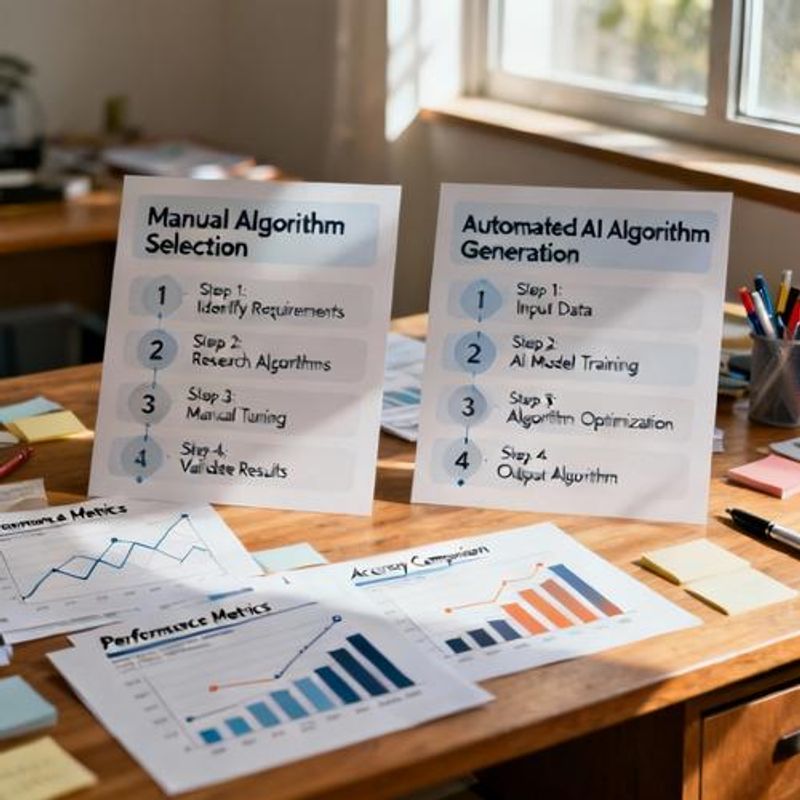AI Algorithm Generator for Data Analysis: Complete Guide to Automated Model Selection and Implementation

Struggling to choose the right algorithm for your dataset? Spending hours coding models from scratch only to find suboptimal performance? AI algorithm generators are transforming how data analysts approach model selection and implementation. This comprehensive guide shows you how to leverage automated algorithm generation to accelerate your analysis workflow, improve model accuracy, and focus on insights rather than implementation details.

Why Data Analysts Need AI Algorithm Generators
Modern data analysts face increasing pressure to deliver faster insights while handling more complex datasets. Traditional algorithm selection involves extensive trial-and-error, requiring deep knowledge of dozens of algorithms and their hyperparameters. You're expected to be an expert in regression, classification, clustering, and time series analysis while also understanding business requirements and data preprocessing. AI algorithm generators address this complexity by automatically testing multiple algorithms, optimizing parameters, and providing performance comparisons—letting you focus on interpreting results rather than implementing models.
Key Benefits: What You'll Gain
AI algorithm generators deliver measurable improvements to your analysis workflow:
- Reduce model development time by 60-80% through automated testing and optimization
- Discover unexpected algorithm combinations that outperform traditional approaches
- Eliminate bias from personal algorithm preferences or limited experience
- Generate production-ready code with proper documentation and error handling

Types of AI Algorithm Generators for Data Analysis
AutoML platforms like H2O.ai, DataRobot, and Google AutoML handle end-to-end model development. These tools automatically preprocess data, select features, test algorithms, and tune hyperparameters. Code generation tools such as GitHub Copilot and Tabnine assist with writing specific algorithm implementations, while neural architecture search platforms like AutoKeras design custom neural networks. Hybrid solutions combine multiple approaches, offering both automated model selection and custom code generation capabilities.
Step-by-Step Implementation Strategy
Start by clearly defining your problem type: regression, classification, clustering, or time series forecasting. Upload your cleaned dataset to your chosen AI algorithm generator, ensuring proper data types and handling missing values. Configure the target variable and evaluation metrics aligned with your business objectives. Set computational constraints including maximum training time and model complexity. The generator will test multiple algorithms, perform cross-validation, and rank results by your specified metrics. Review the top-performing models, examining feature importance and validation scores before selecting your final algorithm.
Practical Examples and Templates
For customer churn prediction, configure binary classification with precision-recall optimization. Upload features like transaction history, engagement metrics, and demographic data. The generator might recommend ensemble methods combining gradient boosting and neural networks. For sales forecasting, use time series configuration with MAPE evaluation. Include seasonal indicators, economic variables, and promotional calendars. Expect recommendations for ARIMA variants, Prophet, or LSTM networks. For market segmentation, select unsupervised clustering with silhouette score optimization. Include behavioral, demographic, and transactional features for algorithms like K-means, DBSCAN, or hierarchical clustering.

Common Pitfalls and How to Avoid Them
Avoid data leakage by carefully reviewing automatically generated features—some tools may inadvertently include future information in historical predictions. Don't blindly trust the highest-scoring model without validating on truly unseen data; generators optimize on validation sets that may not represent future performance. Resist the temptation to skip data quality checks; garbage in still means garbage out, regardless of algorithm sophistication. Be cautious of overfitting when generators create overly complex models; simpler alternatives often generalize better. Always review generated code for production readiness, as some tools prioritize performance over maintainability.
Next Steps: Implementing AI Algorithm Generators in Your Workflow
Start with a low-stakes project to familiarize yourself with AI algorithm generators before applying them to critical business decisions. Compare generated models against your current approaches to build confidence in the tools. Establish validation protocols that go beyond automated metrics to include business logic and domain expertise. As you become comfortable with these tools, gradually integrate them into your standard analysis workflow while maintaining the analytical rigor that makes you valuable as a data professional.